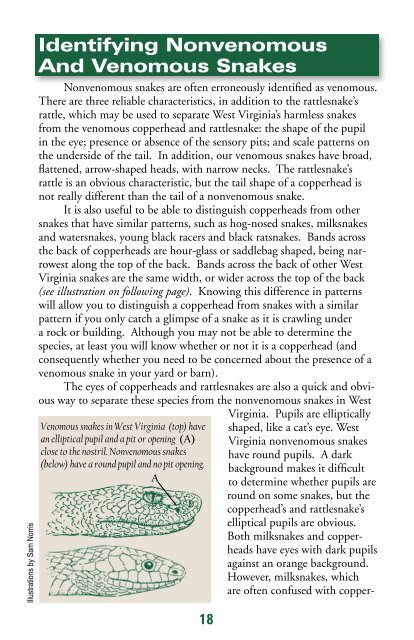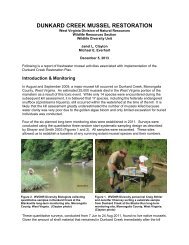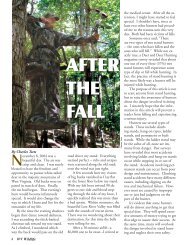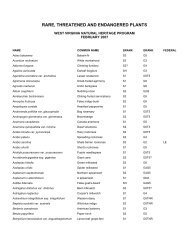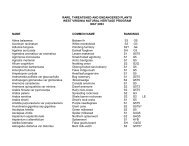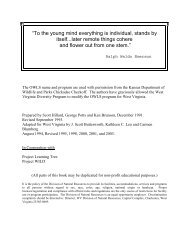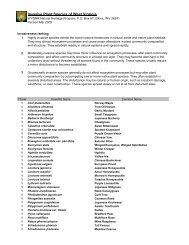Snakes - West Virginia Division of Natural Resources
Snakes - West Virginia Division of Natural Resources
Snakes - West Virginia Division of Natural Resources
You also want an ePaper? Increase the reach of your titles
YUMPU automatically turns print PDFs into web optimized ePapers that Google loves.
Illustrations by Sam Norris<br />
Identifying Nonvenomous<br />
And Venomous <strong>Snakes</strong><br />
Nonvenomous snakes are <strong>of</strong>ten erroneously identifi ed as venomous.<br />
There are three reliable characteristics, in addition to the rattlesnake’s<br />
rattle, which may be used to separate <strong>West</strong> <strong>Virginia</strong>’s harmless snakes<br />
from the venomous copperhead and rattlesnake: the shape <strong>of</strong> the pupil<br />
in the eye; presence or absence <strong>of</strong> the sensory pits; and scale patterns on<br />
the underside <strong>of</strong> the tail. In addition, our venomous snakes have broad,<br />
fl attened, arrow-shaped heads, with narrow necks. The rattlesnake’s<br />
rattle is an obvious characteristic, but the tail shape <strong>of</strong> a copperhead is<br />
not really different than the tail <strong>of</strong> a nonvenomous snake.<br />
It is also useful to be able to distinguish copperheads from other<br />
snakes that have similar patterns, such as hog-nosed snakes, milksnakes<br />
and watersnakes, young black racers and black ratsnakes. Bands across<br />
the back <strong>of</strong> copperheads are hour-glass or saddlebag shaped, being narrowest<br />
along the top <strong>of</strong> the back. Bands across the back <strong>of</strong> other <strong>West</strong><br />
<strong>Virginia</strong> snakes are the same width, or wider across the top <strong>of</strong> the back<br />
(see illustration on following page). Knowing this difference in patterns<br />
will allow you to distinguish a copperhead from snakes with a similar<br />
pattern if you only catch a glimpse <strong>of</strong> a snake as it is crawling under<br />
a rock or building. Although you may not be able to determine the<br />
species, at least you will know whether or not it is a copperhead (and<br />
consequently whether you need to be concerned about the presence <strong>of</strong> a<br />
venomous snake in your yard or barn).<br />
The eyes <strong>of</strong> copperheads and rattlesnakes are also a quick and obvious<br />
way to separate these species from the nonvenomous snakes in <strong>West</strong><br />
Venomous snakes in <strong>West</strong> <strong>Virginia</strong> (top) have<br />
an elliptical pupil and a pit or opening (A)<br />
close to the nostril. Nonvenomous snakes<br />
(below) have a round pupil and no pit opening.<br />
A<br />
18<br />
<strong>Virginia</strong>. Pupils are elliptically<br />
shaped, like a cat’s eye. <strong>West</strong><br />
<strong>Virginia</strong> nonvenomous snakes<br />
have round pupils. A dark<br />
background makes it diffi cult<br />
to determine whether pupils are<br />
round on some snakes, but the<br />
copperhead’s and rattlesnake’s<br />
elliptical pupils are obvious.<br />
Both milksnakes and copperheads<br />
have eyes with dark pupils<br />
against an orange background.<br />
However, milksnakes, which<br />
are <strong>of</strong>ten confused with copper-


